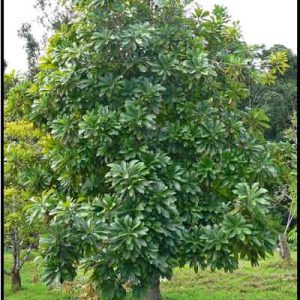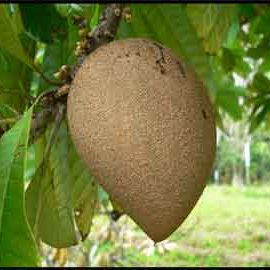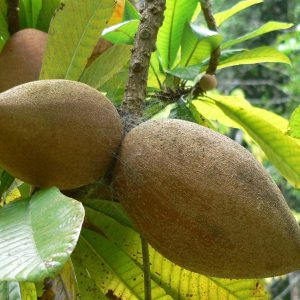Pouteria sapota
Mamey sapote
Origin
Native to Central America and Mexico.
Climate
A tropical species that grows best in humid lowlands with temperatures of 25-33°C and well-distributed rainfall of 900-1800mm pa. It grows up to 1400m in the tropics and is sensitive to frosts, water-logging and prolonged drought. Temperatures below 15°C depress fruit development and brief dry periods will cause leaf shedding. In sub-tropical environments it will likely drop all its leaves in late winter but with rapid replacement.
Plant Description
It is a laticiferous tree, usually 10-15m tall but sometimes larger in its preferred climate, with a spreading and open crown. The simple alternate obovate glossy green leaves are large, 10-30cm long, with prominent veins and clustered towards the ends of branches.
Relatives
Sapotaceae Family. Related to abiu, sapodilla, canistel, star apple.
Soils
Undemanding if well-drained, from heavy clays to sandy and calcareous soils.
Propagation
Commonly by seeds. However they are recalcitrant and need to be sown fresh. Occasionally, seeds are viviparous. Seedling trees aren’t true to type and they produce a larger tree than if grafted. They should mainly be used only as rootstocks, with budding and grafting the main means of propagation. This is more difficult than for many species given the copious latex.
Cultivars
Some cultivars are Pantin, Florida and Magana. These can be difficult to source here, but Pantin is sometimes available.
Flowering and Pollination
The small white to creamy-white sub-sessile flowers are hermaphrodite with 5 stamens, 5 staminodes and a single inferior ovary. Inflorescences are ramiflorous in fascicles of 5-6 in the axils of fallen leaves. Pollination is achieved by honey bees and other insects. Cross pollination improves fruit set.
Cultivation
They should be planted where they will get full sun. Young plants are tender and need to be protected from frost and wind. When young, maintenance of adequate moisture is essential, and when mature, it is important during flowering, fruit set and development. Complete and regular fertilization with trace elements should be undertaken. The frequency of application can be decreased as the plant matures, with the annual amounts increasing commensurate with size.
Mulching is helpful.
Wind Tolerance
Damage due to strong winds is minimised with appropriate size containment, and this will also facilitate harvesting and spraying.
Pruning
Prune to keep the tree a reasonable height for harvest.
The Fruit
Fruit is an ellipsoid climacteric berry, 7 to 25cm long and 0.3 to 2.5kg, often pointed at the apex. The scurfy rind is brown, rough and leathery-woody.
Fruit pulp is deep orange to salmon pink, smooth or finely granular, aromatic and very sweet with 25-34% carbohydrates, enclosing 1-4 large black ellipsoid seeds with a marked light brown hilum. The edible pulp represents about 70% of whole fruit weight. It is quite nutritious with good Ca, Fe, Mg and vitamin C levels. Carotenoid content is similar to carrots and higher than mango and pawpaw.
Fruit Production and Harvesting
Seedling trees may take 7-8 years to bear fruit, grafted plants 3-4. Mamey sapotes can be very prolific, with well-managed mature trees producing 200-600 fruits. The harvesting season varies with cultivar and with judicious selection fruit can be obtained for much of the year. As fruit take 16-20 months to mature from blossom, trees may simultaneously have flowers together with young and more mature fruit on the tree at one time. Deciding when to harvest fruit can be gauged by lightly scratching the surface – if the underlying tissue has turned from green to orange-red then they can be picked. They will ripen and soften in 3-7 days at room temperature. Mature fruits store reasonably well at 10-13°C; lower temperatures cause chilling injury.
Fruit Uses
Mainly eaten fresh by spooning out the pulp, but also in processed forms such as milk shakes and smoothies, ice cream, jams etc.
Pests and Diseases
Various scales and anthracnose can attack the plant but usually there are few problems.
Comments
Mamey sapote is a top exotic fruit, but our winters are colder than it prefers and moisture levels need to be maintained. A named cv should be obtained, as seedling plants are a second-best option.
Be cautious of the latex; it can irritate skin and eyes.



